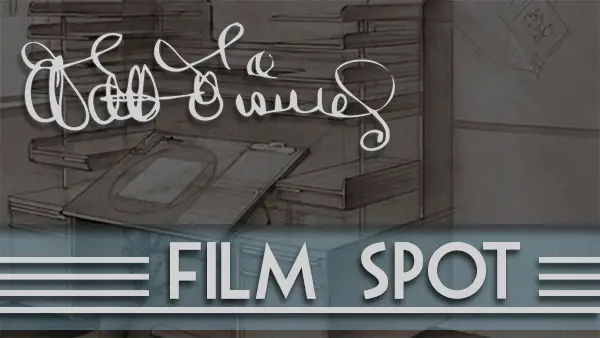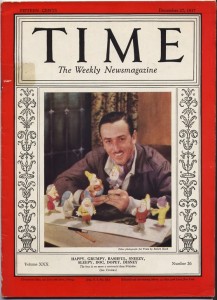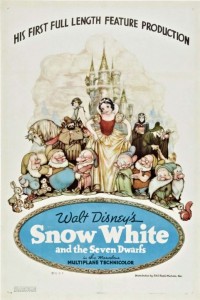Much can be said about Snow White and the Seven Dwarfs. The usual reasons for its universal acclaim range from it being the “first full-length animated feature” to “the first Disney fairy tale”. However, these reasons alone aren’t enough to justify the film’s longevity; if that were so, we would only remember it for historical purposes. To understand the significance of Snow White and the Seven Dwarfs, we need to expand the scope of its influence beyond 1937, find out why it’s been so prevalent for over 70 years, and then zone back in towards the Golden Age of Hollywood and how its creation in that time and place set it up for universality and lastingness.
In the late 20s and early 30s, the Disney Studios was already feeding off the success of Mickey Mouse, Silly Symphony, and other shorts of the time intended to fill time for feature films. Walt Disney’s numerous “firsts” (first synchronized sound, first three-strip Technicolor) had already cemented his name in film history texts, yet the desire for Disney to become a feature-length studio producer the likes of Carl Laemmle or Jack Warner most likely lied dormant in his heart since his move to Hollywood in 1923. Then, Disney was just another hopeful idealist who longed to direct major productions. Eventually he fell back into his role as a cartoonist and animation producer when his Hollywood dreams were less than successful.
However, unlike other animation heads like the Fleischers or Pat Sullivan, Walt Disney managed to become a Hollywood celebrity all the same, playing polo matches with the likes of Will Rogers and Darryl Zanuck. By the time Disney debuted Snow White and the Seven Dwarfs at the Carthay Circle Theatre, he wasn’t thought of as the two-bit cartoonist from Kansas City, but as an influential Hollywood player. Despite being labeled Disney’s Folly, Snow White had visible and influential supporters in the form of Hollywood that guaranteed its success and longevity.
The celebration of Snow White and the Seven Dwarfs lies not in the fairy tale itself, but the achievements that it built for the animation world. Adding a level of dimension and realism to character animation, from the bluebirds that fly over Snow White’s head to the rabbits that furrow underground as she sings, Disney evolved beyond a gag factory of laughter to an entity capable of telling stories of emotions and pathos, fully embracing both masks of classical Greek drama. Its technical achievements rivaled its storytelling achievements. To fully create a world, render out its inhabitants, and deviate from the protagonist’s story to add depth was an aspect of filmmaking that animation never thought it could achieve. Every aspect of art was rendered out to its fullest detail; every piece of animation was painstakingly inked and painted; every background put under the multiplane, every acting motivation was debated and chosen by a team of skilled story men who quickly evolved from vaudevillian comedy writers to masters of prose and diction.
In many ways, Snow White also marked the debut of the modern-day animation industry, generating a new team of artists and craftsmen bred especially for the purpose of changing the artistic paradigm. Up until the release of Snow White, Disney’s animators comprised of New York cartoonists, most of who had applied their newspaper comic strip background to the motion picture industry. Initially limited by their sensibilities and draftsmanship, they had to return to art school to prepare for the complex animation required in Snow White, which grew less and less broad each day. In the production of the film, Disney had slowly trained a new group of animators, fresh from art school, who would eventually become the chief animators at the Disney Studios for the next fifty years. Gone was the New York sensibility, the shadow of the vast Hearst and Pulitzer empires faded away as these animators reported to one man and one man alone, Walt Disney. Even today, artists flock to Los Angeles in hopes of breaking into the animation industry, which has become one of the biggest, if not the biggest market of US commerce. The small Hollywood animation industry introduced a fairy tale-like sensibility to the works of Disney, and Snow White was the first to present this world. No longer chained to the social and political changes of the 20th century, Disney was now able to make any type of film he wanted to, and have it speak to every age, every generation, every country, every decade.
To look back at Snow White and the Seven Dwarfs is to look back at a canvas that’s still wet and revolutionary. Nowhere to be found in Snow White is the Great Depression, the beginnings of World War II, or any other political or social nature of the time period. Its creation echoed the treatment and tonality of films to come. Initially presented to imitate live-action storytelling, now films like The Wizard of Oz attempt to imitate the animation canvas. Hollywood moved beyond simply dramas and comedies and brought back genres not explored since the days of George Méliès – namely, the fantasy genre. To say it is a timeless body of work does not hold up the film historically or critically, but to say that it was a catalyst of change and growth whose influence is still shaking up the world today brings us closer to understanding how Disney’s Folly set up the next century’s progress.








